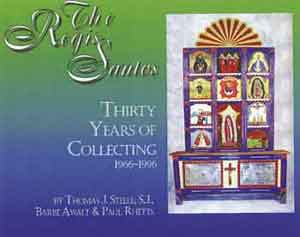by Father Thomas Steele, S.J., Barbe Awalt and Paul Rhetts
10-1/2 x 8-1/2 96 pages; 134 color photographs
HARDCOVER 0-9641542-4-2 $39.95
SOFTCOVER 0-9641542-7-7 $29.95 SOLD OUT

DESCRIPTION
The Regis University Collection of New Mexican Santos is the largest teaching collection of santos in the United States. This book documents three hundred pieces of Spanish Colonial and contemporary devotional art that have been assembled by Father Thomas Steele over thirty years. This is the first time an entire university collection of New Mexican santos has been documented for the general public.
Although the book tells the stories behind the acquisition of the santos over a thirty year period, the tradition and images cover almost four hundred years of New Mexican history. The collection contains examples of the master santeros from the eighteenth and nineteenth centuries as well as contemporary masters like Charlie Carrillo, Félix López, Max Roybal, Gustavo Victor Goler, Alcario Otero, Arlene Cisneros Sena, Frank Brito, Jimmy Trujillo and David Nabor Lucero.
This is a commemorative book to mark the thirtieth anniversary of the Regis University Collection of New Mexican Santos, which is housed in the Dayton Memorial Library on the Regis campus in Denver, Colorado.
REVIEWS
"The Regis Santos documents the three hundred pieces of Spanish Colonial and contemporary devotional art that have been assembled by Father Thomas Steele over thirty years and are assembled as the Regis university Collection of New Mexican Santos. The collection contains examples of the master santeros from the 18th and 19th centuries as well as contemporary masters. Father Steele, assisted by Barbe Awalt and Paul Rhetts, has produced a truly impressive and seminal body of work." -- Midwest Book Review/Bookwatch, August 1997
[This review also appeared in the Midwest Book Review's "Internet Bookwatch;" posted on the internet discussion group alt.books.reviews; forwarded for inclusion in Gale Research Company's interactive CD-ROM series "Book Review Index;" and posted to six internet bookstores (Amazon-com, ReadersNdex, Muze, Book Stacks Unlimited, Daremore Bookstore and BookWire).]
"This book is a personal history of what it is to assemble such a collection on a limited budget. The result is a personal, sometimes humorous, and always thoughtful story of one individual's consummate love affair with a distinctive art form. This is an important book because santos are such an important part of the Hispanic culture and geography of New Mexico, and they are so deeply rooted in the traditions of Spanish and Mexican Catholicism." -- Sandoval Arts, September 1997
"In The Regis Santos Steele describes how every piece was acquired - purchase, trade or gift - and it's obvious that the process is as rewarding, and memorable, as the acquisition. Gently witty, and often punny, it also is instructive in the many ways that a collection may be honed and improved within a budget. And while some collectors would despair, or be mortally embarrassed, by inadvertantly investing in a fake, Steele considers fakes instructive and valuable in a collection - but only if you learn from them." -- Denver Post, November 2, 1997
"This book commemorates the thirtieth anniversary of the Regis University Collection of New Mexican santos. Its publisher specializes in traditional Spanish Colonial arts and culture. Father Steele collected three hundred examples of work by New Mexico santeros and santeras from the eighteenth century to the present. Since the Regis Collection is a teaching collection, the book is also a learning experience. It also tells the story behind the gathering of this important group of examples. There are 134 color photographs and some black and white ones. There is a complete list of the Regis santos with dates and other pertinent information. There are two bibliographies, one of the writings of Father Steele and the other relating to santos and to Spanish Colonial art." -- Enchantment, November 1997
"[Tom Steele's] name is often associated with the study of santos and is well-known for his love of Hispanic people, nuestra santa raza. For the past thirty years, Steele has been more than just a collector. He's been a student, secondly a teacher and finally a disciple. In his long pilgrimage and struggle to learn about the Hispano and genízaro, he studied and became a priest. I gather from those who know him, he experienced a cultural transformation. . . . This is what being a genízaros is all about. What intrigued me most about the Regis collection is that it clearly and unquestionably demonstrates that the New Mexico santero tradition extends beyond the contemporary political boundaries of New Mexico. This book is more than a catalog of the Steele collection. It is a preview of the santero talent of our hermanos carnales in Colorado." -- La Herencia del Norte, Winter 1997
Father Thomas Steele has spent 30 years assembling a teaching collection of 300 New Mexico Santos for Regis University in Denver (where he taught English until recently). The collection ranges from Spanish Colonial to contemporary. Many of these items are illustrated (in 134 color photos), and how and why they were acquired is carefully explained. The many people who admire Father Steele's work can learn more about his career in this book, as the various chapters are rather personal statements about his life and scholarly endeavors. A complete list of his published writings is included, as is a list of suggested readings on Santos by other authors. A catalog of the Regis collection completes this interesting and pleasing volume. -- Book Talk, April 1998
THE REGIS SANTOS was voted and ended up in the top 52 favorite NM books by the New Mexico Book League. (April 1998)
Regis University, in Denver, Colorado, owns one of the largest teaching collections of santos in the United States. The Regis Santos documents 300 pieces of Spanish Colonial and contemporary devotional art. It was assembled by Father Thomas J. Steele and is open to the public in the University's Dayton Memorial Library. Steele was on the Regis faculty for 30 years until his retirement in 1997. Early in his teaching career he discovered santos art and has become an authority on this unique art form. His best-known work, Santos and Saints (Ancient City Press, 1974), is now in its third edition.
Santos, devotional art, developed in the Spanish settlements of northern New Mexico and spread to southern Colorado over a period of almost 250 years (1598-1820). A culture evolved in which settlers produced their own textiles, furniture, and religious objects. New Mexicans of Spanish descent practiced a Catholicism that required a large number of images of the Holy Trinity, Christ the Madonna, the Holy Family, and the saints of the Christian faith. Three different kinds of santos were made for churches and home altars: retablos, paintings on wood, usually pine, coated with gesso (a mixture of gypsum and animal glue), on which images are painted with watercolors or with pigments made from organic materials; bultos, statues carved from cottonwood roots, either unpainted or coated with natural pigments; and reredos, large structures created to be placed behind altars and consisting of columns, niches, and a series of retablos joined together.
For the artists of northern New Mexico and southern Colorado, aesthetics was less important than the goodness and passion of the santero. The objects were not perceived as mere works of art but as emblems of spiritual homage and transcendence. These folk-art expressions possess both a naivete and the sophistication of directness and simplicity.
The art of creating these religious icons reached its peak in the mid-19th century. After 1850, with improved transportation, cheaply manufactured religious objects began to flood the market. With the availability of mass-produced goods, tastes began to change. Plaster-of-paris statues began to replace the old wooden bultos, and prints and calendars replaced the retablos of pine. The number of people involved in the production of handcrafted religious objects began to decline and the art form almost died out.
However, these traditional crafts never disappeared. Through the efforts of the Colonial New Mexico Art Society, a Spanish Market was established in Santa Fe in the 1940s, making it possible for 20th-century pioneer santeros to sell their art. The Spanish Market has become one of the largest centers for the sale of this increasingly popular art form.
The Regis University Collection contains examples of the master santeros from the 18th and 19th centuries, contemporary New Mexican masters, as well as the movingly beautiful Aurora Altar Screen, which is handsomely reproduced on the cover. It was created by 10 Colorado santeros in 1996 for the "Santeros del Norte" exhibit at the Aurora History Museum. The Regis Santos brings attention to a unique collection whose central purpose is interpretation and teaching, unlike museums or private collections with their focus on aesthetic excellence. -- Bloomsbury Review, May/June 1998
AUTHOR INFORMATION
Father Thomas J. Steele has been a respected member of the Regis University English Department faculty for thirty years. Tom has also curated the Regis University Collection of New Mexican santos as well as a small collection of Native American artifacts, both housed at the Dayton Memorial Library on the Regis University Campus. He is most known for Santos & Saints (Ancient City Press) first published in 1974 and now in its third edition. His other writings cover a wide range of topics ranging from English literature, Hispanic religious history of New Mexico, and the history of the Southwest.
Father Steele currently resides in Albuquerque at the Immaculate Conception Parish. He is still actively researching the santos of New Mexico and writing on topics of historical interest. He also teaches part-time at the University of New Mexico on the religious history of New Mexico. Tom still haunts the antique stores of Canyon Road and Central Avenue looking for santos to rehabilitate and add to the Regis Collection.

